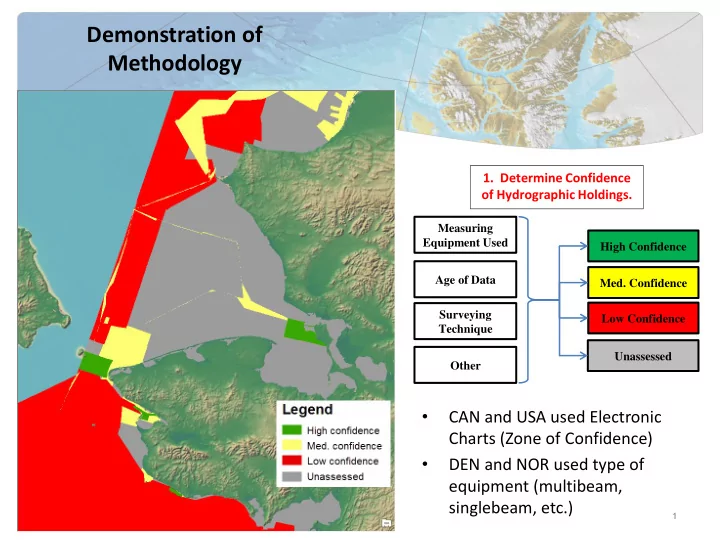

Demonstration of Methodology 1. Determine Confidence of Hydrographic Holdings. Measuring Equipment Used High Confidence Age of Data Med. Confidence Surveying Low Confidence Technique Unassessed Other • CAN and USA used Electronic Charts (Zone of Confidence) • DEN and NOR used type of equipment (multibeam, singlebeam, etc.) 1
Demonstration of Methodology 2. Define Depth Bands based on Seafloor Complexity. Simple: 0-20m Shallow Simple: 0-20m, 20-50m 20-50m, Depth > 50m 50+ m + Mid-depth Seafloor Complex: 0-100m, Complex: 0-100m Complexity 100-200m, 100-200m 200+ m > 200m Deep • The seafloor in this area is considered “simple” (as opposed to the tectonically-active Aleutian chain). • All depths derived from the International Bathymetric Chart of the Arctic Ocean (IBCAO) dataset. 2
Demonstration of Methodology 3. Intersect Areas of Confidence with Depth Areas to determine Potential Areas of Concern. (e.g. Higher Confidence Lowest Concern and/or Deeper Depths) Low Concern Med. Concern High Concern (e.g. Lower Confidence Highest Concern and/or Shallower Depths) • The darker the color, the greater the potential for concern… • However, the areas are only truly concerning if they are being navigated by traffic. 3
Demonstration of Methodology • Side-by-side view showing the intersection between the Areas of Confidence (left) and the Depth Areas (center) to yield the Potential Areas of Concern (right). Presentation to PAME II 2014 4
Demonstration of Methodology 4. Extract “High Risk” Vessel Traffic Tracklines * and Intersect with Potential Areas of Concern. Satellite-Observed Vessel Traffic Patterns Output: • Frequency of Vessels Higher Risk Vessels: • Tankers transiting within Areas of Higher/Lower Concern… • Cargo and Tugs • … thus quantifying whether • Passenger Vessels region is adequately charted. • Notice there are three shallow bays with an Unassessed * confidence (marked with an *)… • While all three were previously identified as potential areas of concern, only the center one experiences heavy traffic (thus, it could be increased in survey * priority over the others). 5
Demonstration of Methodology 5. Compute Area Geometry of Potential Areas of Concern and Linear Distance Traversed by Vessel Traffic within each Area type. • Vessel tracks can now be parsed based on how often they transit within any given depth- confidence combination to quantify the problem for any region. • See next slide for summary tables… 6
Recommend
More recommend